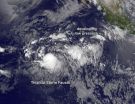(Press-News.org) Hand hygiene rates were found to be three times higher when auditors were visible to healthcare workers than when there were no auditors present, according to a study in a major Canadian acute care hospital.
The study, titled, "Quantification of the Hawthorne effect in hand hygiene compliance monitoring using an electronic monitoring system: a retrospective cohort study," published today on-line in the BMJ Quality & Safety Journal, by first author Dr. Jocelyn Srigley, who did the study as part of her Master's thesis while a Clinical Fellow in Infection Prevention and Control at University Health Network and University of Toronto and senior author Dr. Michael Gardam, Director, Infection Prevention and Control, University Health Network and Women's College Hospital. Link: http://qualitysafety.bmj.com/cgi/rapidpdf/bmjqs-2014-003080?ijkey=JPbRe7gYzAFsm1Z&keytype=ref
The study examined the Hawthorne effect, also known as observation bias – the tendency of people to change their behavior when they are aware of an observer – using an electronic monitoring hand hygiene system in real-time, eliminating many of the biases inherent to human observation. Ultrasound "tags" on soap dispensers transmitted a signal to a nearby receiver each time the levers were pushed, and a time-stamped hand hygiene wash was recorded in a central data base.
Two inpatient units in University Health Network were electronically monitored, with 60 healthcare workers volunteering to be part of a study of the electronic monitoring system. Staff were aware that data would be used in a variety of studies, but were "blind" to the questions asked in the studies. Auditors did not announce their presence during audits but wore white lab coats. Auditors were also blinded to the questions asked in the research. Hand hygiene dispenses were electronically measured while the auditors were visible, and were compared to the same locations prior to the arrival of the auditors at one, two and three weeks before the audit, as well as to a different area of the unit not visible to the auditor. Auditors typically did not go into patient rooms, so separate hand washing rates were determined for dispensers inside patient rooms and those in hallways. Twelve audits were included between November 2012 and March 2013.
The study found that there was an approximately three-fold increase in the rate of hallway hand washes per hour amongst healthcare staff when an auditor was visible (3.75 per hour), compared to a location where the auditor was not visible (1.48 per hour) and to the previous weeks (1.07 per hour). Hand washing rates with the auditor present were compared to separate groups at different time periods and locations to ensure that the differences found were not due to hand hygiene patterns that could be attributable to time of day or location. In each instance, the hand washing rates were significantly higher when the auditors were present, with the increase occurring after the auditors' arrival, suggesting that the arrival of the auditor triggered the increase in hand hygiene.
"The difference in hand hygiene rates, when an auditor is present compared to those times when one is not, is huge in this study, and we showed this effect to be very consistent," says Dr. Gardam, who is also an Associate Professor of Medicine at the University of Toronto.
"The magnitude of what we found calls into question the accuracy of directly observed hand hygiene rates and the usefulness of measuring and reporting them," says Dr. Gardam. "That said, human auditing of hand hygiene has been helpful to draw attention to this important preventative measure—we just can't stop focusing on it because our posted rates are not nearly as high as we think they are."
Dr. Srigley says that although the researchers were "surprised at the tripling effect" of having an auditor present, there may still be some value in doing audits as there could be opportunities for in-the-moment education with health care staff. Dr. Srigley is the Associate Medical Director of Infection Prevention and Control at Hamilton Health Sciences, composed of seven hospitals in the Hamilton area.
Dr. Gardam suggests that a "front-line staff ownership" approach which engages rather than "nags" staff is a good option. This approach was first brought to University Health Network about six years by Dr. Gardam, in which front-line staff have developed their own reminders to influence staff to wash their hands, including: pancake breakfasts, public unit reporting, pledges, posters, and holding each other accountable.
"We need to change how we look at these complex problems," says Dr. Gardam, "We need to help people change by engaging them and having them come up with local solutions."
INFORMATION:
This work was supported by grants from Canada Health Infoway and the Health Technology Exchange, by Infonaut Inc., and by GOJO Industries. Dr. Srigley received salary support from the AMMI Canada/Astellas Post-Residency Fellowship.
The study sponsors had no role in the design and conduct of the study, or preparation, review or approval of the data and manuscript.
About University Health Network
University Health Network includes Toronto General and Toronto Western Hospitals, Princess Margaret Cancer Centre, and Toronto Rehabilitation Institute. The scope of research and complexity of cases at University Health Network has made it a national and international source for discovery, education and patient care. It has the largest hospital-based research program in Canada, with major research in cardiology, transplantation, neurosciences, oncology, surgical innovation, infectious diseases, genomic medicine and rehabilitation medicine. University Health Network is a research hospital affiliated with the University of Toronto. http://www.uhn.ca
For media interviews, please contact:
Alex Radkewycz
Senior Public Affairs Advisor
Toronto General Hospital, University Health Network
Ph: 416 - 340 – 3895
BB: 647 – 821 - 4624
Email: Alexandra.Radkewycz@uhn.ca
Follow us:
http://www.UHN.ca
@UHN_News
Facebook.com/UniversityHealthNetwork
Health-care worker hand hygiene rates increase three-fold when auditors visible
2014-07-08
ELSE PRESS RELEASES FROM THIS DATE:
LJI develops new approach to identify genes poised to respond in asthma patients
2014-07-08
SAN DIEGO – July 8, 2014 In a study published yesterday in the scientific journal Nature Immunology, a group at the La Jolla Institute (LJI) led by Pandurangan Vijayanand, Ph.D. identify new genes that likely contribute to asthma, a disease that currently affects over 200 million people world wide.
An organism's genetic material, also known as its genome, can be divided into small sections or 'neighborhoods.' Scientists can determine which genetic neighborhoods in a cell are active, or primed for gene production, by looking for a marker on the genome called an enhancer. ...
Astronomers bring the third dimension to a doomed star's outburst
2014-07-08
VIDEO:
NASA Goddard astrophysicists Ted Gull and Tom Madura discuss Eta Carinae and their new model of the Homunculus Nebula, a shell of gas and dust ejected during the star's mid-19th...
Click here for more information.
In the middle of the 19th century, the massive binary system Eta Carinae underwent an eruption that ejected at least 10 times the sun's mass and made it the second-brightest star in the sky. Now, a team of astronomers has used extensive new observations to create ...
NASA's SDO spots a summer solar flare
2014-07-08
The sun emitted a mid-level solar flare, peaking at 12:20 p.m. EDT on July 8, 2014, and NASA's Solar Dynamics Observatory captured images of the event. Solar flares are powerful bursts of radiation. Harmful radiation from a flare cannot pass through Earth's atmosphere to physically affect humans on the ground, however -- when intense enough -- they can disturb the atmosphere in the layer where GPS and communications signals travel.
To see how this event may affect Earth, please visit NOAA's Space Weather Prediction Center at http://spaceweather.gov, the U.S. government's ...
NASA-JAXA's new precipitation satellite sees first Atlantic hurricane
2014-07-08
VIDEO:
The animation begins with global infrared data showing the progression of the storm as it forms into a hurricane. Then GPM flies overhead measuring rain rates on the ground. GPM's...
Click here for more information.
The Global Precipitation Measurement (GPM) Core Observatory flew over Hurricane Arthur five times between July 1 and July 5, 2014. Arthur is the first tropical cyclone of the 2014 Atlantic hurricane season.
GPM is a joint mission between NASA and the Japan ...
Satellite sees newborn Tropical Storm Fausto being 'chased'
2014-07-08
Tropical Storm Fausto was literally born yesterday and strengthened to a tropical storm quickly. Satellite imagery from NOAA's GOES-West satellite shows a rounded Fausto being "chased" by a developing area of low pressure to the east of the storm.
NOAA's Geostationary Operational Environmental Satellite GOES-West captured a combination visible and infrared image of the Eastern Pacific on July 8 at 1500 UTC (10 a.m. EDT). In the image, Tropical Storm Fausto appeared as a rounded area of clouds, compared to the amorphous developing low pressure area behind it.
At 6:30 ...
NCI study finds extreme obesity may shorten life expectancy up to 14 years
2014-07-08
Adults with extreme obesity have increased risks of dying at a young age from cancer and many other causes including heart disease, stroke, diabetes, and kidney and liver diseases, according to results of an analysis of data pooled from 20 large studies of people from three countries. The study, led by researchers from the National Cancer Institute (NCI), part of the National Institutes of Health, found that people with class III (or extreme) obesity had a dramatic reduction in life expectancy compared with people of normal weight. The findings appeared July 8, 2014, in ...
Virtual reality crowds produce real behavior insights
2014-07-08
VIDEO:
Researchers at Brown University have developed a wireless virtual reality system to better understand how pedestrians interact with one another and generate patterns of crowd movement.
Click here for more information.
PROVIDENCE, R.I. [Brown University] —The cognitive scientists in the Virtual Environment Navigation lab at Brown University are not only advancing a frontier of behavioral research but also of technology.
Led by Professor William Warren, the group developed ...
Three reforms to protect California's cap-and-trade policy
2014-07-08
California's landmark cap-and-trade system for regulating greenhouse gases could be vulnerable to price spikes and market manipulation, according to a new study released by scholars affiliated with the Energy Institute at Haas. But the state's air-quality regulators can prevent that outcome with three straightforward reforms, the study says.
Specifically, the California Air Resources Board should consider (1) strengthening the new market's price collar—the so-called allowance price containment reserve—(2) allowing permits to be converted from one compliance period to ...
Planet Mercury a result of early hit-and-run collisions
2014-07-08
TEMPE, Ariz. - Planet Mercury's unusual metal-rich composition has been a longstanding puzzle in planetary science. According to a study published online in Nature Geoscience July 6, Mercury and other unusually metal-rich objects in the solar system may be relics left behind by collisions in the early solar system that built the other planets.
The origin of planet Mercury has been a difficult question in planetary science because its composition is very different from that of the other terrestrial planets and the moon. This small, innermost planet has more than twice ...
Using sand to improve battery performance
2014-07-08
RIVERSIDE, Calif. (http://www.ucr.edu) — Researchers at the University of California, Riverside's Bourns College of Engineering have created a lithium ion battery that outperforms the current industry standard by three times. The key material: sand. Yes, sand.
"This is the holy grail – a low cost, non-toxic, environmentally friendly way to produce high performance lithium ion battery anodes," said Zachary Favors, a graduate student working with Cengiz and Mihri Ozkan, both engineering professors at UC Riverside.
The idea came to Favors six months ago. He was relaxing ...






